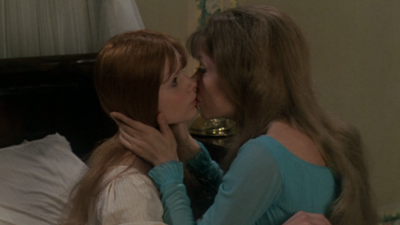"You must die. Everybody must die."
Ah, Hammer Pictures, where men's collars are high and filled with starch, and women's neckline's are low and filled with cleavage. Our look at the studio at the dawn of the 1970's continues with "The Vampire Lovers". Like "Crescendo", this picture shows the studio making a strong start to the decade that would eventually give us Dracula bringing death to the love generation and a Stuart Whitman international action thriller.
We start off with a Hammer double whammy: a fog shrouded graveyard in front of a castle at night. Baron Hartog (Douglas Wilmer) hides in the decrepit castle of the Karnstein's, waiting to take revenge on the dreaded bloodsucker's who took his sister's life. What transpires in this pre-credit sequence is everything you hope to get when you enter the world of Hammer: atmosphere, creepy set's, redder than red blood, a coffin that appears to also be a fog machine and a gorgeous vampire babe. Everything seems to be very traditional, until a shockingly gory decapitation occurs. Welcome to the 70's, Hammer.
Peter Cushing is Hammer royalty, and he is General Speilsdorf and he is throwing a party for his niece, Laura (Pippa Steele). Into the room enter the Countess (Dawn Addams) and Marcilla (Ingrid Pitt), the eye of every man upon them. Laura comments to her beau, Carl (Jon Finch), that Marcilla seems to be checking him out. He disagrees, saying he's not the half of the couple at which the mysterious woman is looking. The Countess asks the General to look after Marcilla while she goes away and he agrees. Throughout the entire picture, but especially in this scene, we see Hammer's trademark bold use of the color red. It's in the General's uniform, the red cape worn by the mysterious man who calls the Countess away, Marcilla's dress and the uniform of the coachmen; the sanguinary hue inhabits every frame.
Laura awakes, screaming in the night, from a dream in which she's being attacked by a giant cat. Uncoincidentally, Marcilla begins to make the move's on her, growing more intimate with each encounter. Soon, a strange sickness takes hold of Laura, who lay in bed repeatedly asking for Marcilla. Moments after she arrives in the room, Laura exits this mortal coil.
Later, The Countess' carriage tips over while journeying through the forest. There's never a shortage of well to do men willing to aid a young lass, so she soon convinces Roger Morton (George Cole) to take in her "daughter", now going by the name of Carmilla. Pitt's sex appeal may be what this picture was sold on, but Madeline Smith, who's plays Emma, Morton's niece, is the most remarkable beauty in the film. Big eyed, with a porcelain fragility, she's like a Keane painting come to life.
Unsurprisingly, Carmilla chooses Emma as her new prey, and no time is wasted before they are getting naked together. The big pussy cat dream makes another appearance, this time experienced by Emma. Whatever the charm's of Tudor Gates screenplay might be, subtlety and unpredictability aren't two of them.
There's a wonderful sequence in which a funeral procession for one of Carmilla's victim's passes on the road by her and Emma. Overwhelmed by the tolling bell and religious chanting, Carmilla finds herself shaken by this mockery of her undying existence. Pitt's screen presence is a mix of Catherine Deneuve and Nico (perhaps LESS vampiric than Nico), with line readings in the kind of cavernous Teutonic monotone you would expect from that combo. In this scene, though, she is truly compelling, bordering on powerful.
Morton goes away for some reason or other, and Carmilla takes this opportunity to use her seductive vampirism to gain power over the household. Carmilla seduces the Governess in a strongly back-lit scene that evinces true artistry. Roy Ward Baker was a Hammer stalwart, and he does some fine work here; the beginning and ending at Karnstein Castle and a scene in which the Doctor who has been caring for Emma is attacked in the leave strewn twilight forest, in particular.
By the end of the film, the race is on as the General, Morton and Hartog try to find Mircalla Karnstein's (the true identity of Marcilla/ Carmilla) grave before poor Emma is consumed by the lust of the dark side. It all ends with Cushing, stake in hand, confronting a vampire in their coffin. So, if you've ever seen, or even heard about a Hammer film, you know how it ends.
"The Vampire Lovers" was part of the Euro-gothic softcore vampire genre that was fairly popular in the 1970's. Other examples are "Vampyres", "Daughter's of Darkness" and a whole load of Jean Rollin (the undisputed master of the genre) and Jess Franco effort's. With the "Karnstein Trilogy" (this picture, along with "Lust For a Vampire" and "Twins of Evil"), Hammer took the lush period atmos-horror stories that were their bread and butter and just added more boob's and lesbo overtone's. Ironically, what's most memorable about this film is how well it employs the more traditional element's of the Hammer style. The shot's of Pitt walking across the fog strewn landscape are haunting and more effective than any flash of t&a might be.
Pitt didn't appear in the other two Karnstein outing's, but would appear in "Countess Dracula" for the studio the following year. I was surprised after watching this picture and "Crescendo" at how strongly Hammer entered the era of modern horror. These two films, along with "Vampire Circus" and "Captain Kronos", made two years later, proved the studio was at their best when they made picture's in their own style without trying to ape current fad's. Despite it's more explicit elements, "The Vampire Lovers" is united with the classic Hammer film's through it's craftsmanship and timelessness.







No comments:
Post a Comment